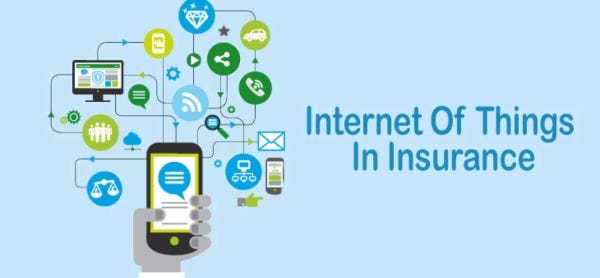The Internet of Things: A paradigm shift in the insurance world The IoT, or the Internet of Things represents a revolution that is affecting many fields, and one to be placed under this category would necessarily have been insurances. IoT is effecting profound change to how insurers assess risk, underwrite policies and serve their customers by linking devices and capturing / analyzing information in real-time. This blog post offers some examples of how IoT is disrupting the insurance industry and influencing everyone involved, from insurers to policyholders in a variety of industries.

1. Internet Enhanced Risk Assessment
One of the key impacts that IoT is making on insurance industry in providing massive real-time data. This was almost impossible for insurers to imagine, until a few years (or months) ago. Connected cars, smart home systems and even wearable health monitors means information will be collected on the very devices that many an insurer could use to get a more accurate rating of risk. For example:
Automobile Insurance — Devices are installed in the vehicles to monitor driving behavior such as speed, braking patterns and acceleration. This data is then employed by insurers for creating more versatile and intelligent insurance policies, in a manner that safe drivers receive fair premiums appropriately reflecting their cautious driving.
Home Insurance: Smart home devices are of great interest to insurers since they provide important information on the safety and security conditions for a property, including data from such things you would like really better in your home — smoke detectors. Together, this information helps insurers underwrite policies in a way that enables more tailored tenders and discounts for property owners with such enhancements.
If insured: Many insurance companies use wearables to track the health data and fitness of policyholders for better monitoring. This can eventually help the insurer to a great extent because higher premium means that those individuals have to follow healthier lifestyle which in turn decrease insurance liabilities.
2. Internet Track and File Instant Claims
Real-time monitoring of insured assetsSuch devices as in the case of IoT make it possible to monitor insured assets real-time and then an insurer could promptly react when incidents occur, thus making any claim processing much faster. For instance:
Property Insurance -Detection of Water Leak, fire or other hazards on real-time basis counter measures could be taken immediate to avoid more loss. This is good for policyholders and lowers the overall exposure to risk of insurer liabilities or losses.
Car insurance: If there’s a crash, for example, ready access to granular data on precisely how those collisions played out can also make insurers confident they understand who caused the sequence of events and consequently provide them with significant claims processing efficiencies. This can mean faster pay-outs for policyholders and reduced operational costs for insurers.
3. Tailored Insurance Products
Insurers can develop personalized insurance products using the data collected by IoT devices, focusing on a per person basis. In turn, with personalization you can improve consumer satisfaction and build more loyalty within your niche. For example:
UBI (Usage-Based Insurance): UBI policies use mechanisms that identify demographics to group drivers behavior and can charge premiums based on actual usage of a vehicle. It meets the demand of a market that is more interested in buying insurance as it goes along and according to their level of risk.
Using data from IoT, companies can dynamically adjust premiums in-context to the changing risk factors due to which they offer a whole new service Dynamic Pricing. This flexibility will probably attract customers who desire some type of protection that is more contingent.
4. Improved Fraud Detection
One of the biggest challenge faced by insurance industry is: Fraud so here IOT can solve almost 90% fraud problems. Analyzing data from connected devices can enable insurers to flag patterns and outliers that may indicate potential fraud activity. For instance:
Correlated data: insurers cross-reference the data received from their own sources (GPS, telematics in claims form) with other relevant ones such as weather and can verify under which conditions a claim was made to find frauds inconsistencies.
These smart contracts were written with an IoT blockchain tech-not seen anywhere before, for literally instantaneous data real-time execution and to prevent any other fraud activities from being able act on their own.
5. Future Trends and Challenges
However, as the Internet of Things progresses further — insurers face several challenges:
DATA PRIVACY AND SECURITY — More data collection = more security responsibilities in protecting that info Preserve value of client trust: More than any other industry today, insurers are required to insure that they always stay on guard and manage right from big liability issues via annual adherence as well regulatory standards.
You should be able to integrate your processes with legacy systems, as most insurers will still have this type of technology. Integrating IoT solutions with current systems are costly & tedious, most importantly — some will be more pocket drain than the other.
Greater Consumer Adoption: While consumer adoption of new IoT devices is increasing, privacy concerns and doubts about data-sharing hang on. Insurers can take this as an opportunity to promote adoption by promoting the benefits, and ensure transparency of these added values.
Conclusion
IoT is revolutionizing the insurance industry, granting access to real-time data like never before and in turn improving risk evaluation along with product personalization while reducing claims processing. This means great things for all, if not most segments of the industry in terms of possibilities and innovation to enhance customer experiences. However, insurers will have to address the issues of data privacy and integration in addition to consumer adoption for IoT that can truly allow them their ultimate global insurance legacy — marking an indelible impression around the world as well.
